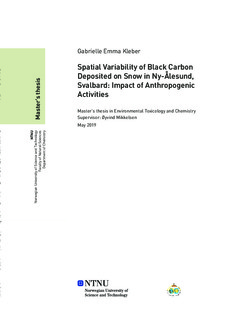| dc.description.abstract | Black Carbon (BC) is a carbonaceous particle emitted globally during the incomplete combustion of biomass and carbon-based fuels. It is considered one of the strongest climate-forcing agents due to its high capacity to absorb solar radiation and heat the atmosphere. When deposited over highly reflective surfaces such as snow and ice, BC particles reduce surface albedo and accelerate the rate of melt. The region around Ny-Ålesund, Svalbard is considered a pristine Arctic site and is used to study background levels of contaminants such as BC in the European Arctic. The spatial distribution of BC on glaciers was used as a proxy to investigate potential environmental impacts of anthropogenic activity in the Ny-Ålesund settlement. Surface snow samples were collected from glaciers at varying altitudes and distances from Ny-Ålesund during spring 2018 and analyzed for BC content by Thermal Optical Analysis. Measurements were compared to a similar dataset gathered during spring 2017, when extensive building activities were underway in Ny-Ålesund. Measured BC levels of 2018 snow samples ranged from 0 ng per gram of snow to 9.8 ng/g, with a mean concentration of 1.9 ng/g. BC levels from 2017 ranged from 0 to 68 ng/g with a mean concentration of 14 ng/g. A comparison of the datasets confirmed that when strong anthropogenic activities are present in Ny-Ålesund, there is a measurable impact on the contaminant levels in snow in the surrounding region. Areas within a 15 km radius of the settlement are most impacted and exhibited 2.3 times higher BC levels than locations further away in 2017 and 1.3 times higher in 2018. Altitude of sampling locations was also a major contributing factor, leading to 1.5 times higher BC levels for sites lower than 450 m.a.s.l. in 2017 and 4.6 times higher levels in 2018. It is therefore recommended that sampling campaigns are completed further than 15 km from Ny-Ålesund and at altitudes greater than 450 m for future studies aiming to measure long range transport of contaminants to Svalbard. | |
